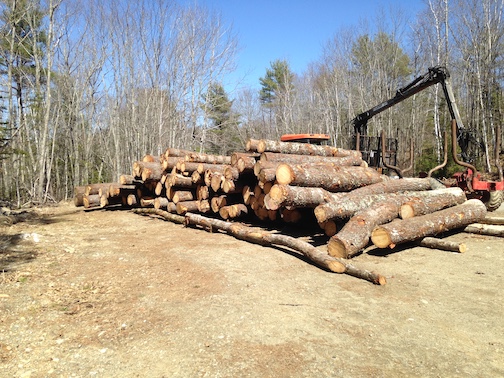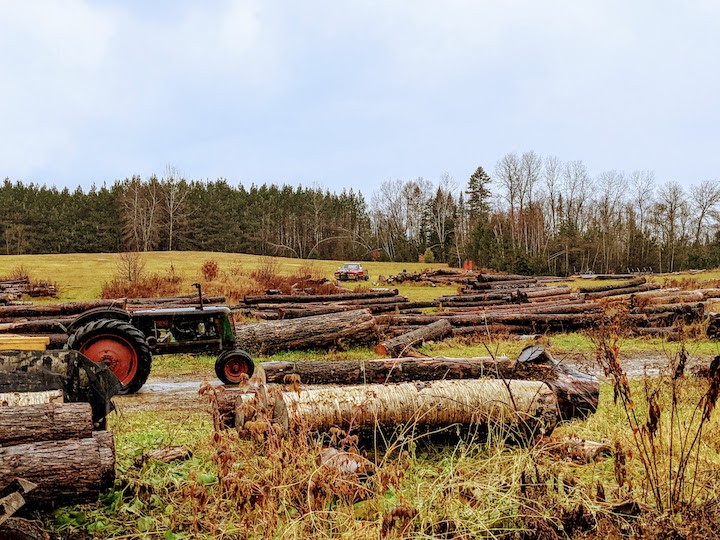By Noah Gleason-Hart
In a low-impact forestry system, humans have an active role to play as forest consumers and stewards as long as we acknowledge our limited understanding of forest ecosystems. LIF recognizes that forest ecosystems are more complex than we currently understand and therefore operates thoughtfully with caution and humility as core principles. Another guiding philosophy of LIF is that wood products can be grown and harvested in a way that maintains the other ecosystem services that fully functioning forests provide. Both of these principles were outlined in a previous column, “What is Low-Impact Forestry?”, which you can read on mofga.org.
Now, we’ll explore two more principles that help us apply this forestry philosophy to action in our woods.
LIF promotes growing and harvesting durable, long-lasting and high-value forest products in perpetuity.
High-quality forest products come from straight, healthy trees. When we grow many high-quality trees and harvest some of them, the financial returns from products like saw and veneer logs support management costs like land taxes, boundary maintenance, and timber stand improvement projects. In addition, fast-growing, vigorous trees play an important role in climate change mitigation. They sequester, or take in, high amounts of carbon and more quickly reach large diameters and become highly effective storers of carbon. Finally, when trees are of a high enough quality to be used for lumber, some of the carbon they contain is stored for as long as the products produced from them are in use. Conversely, low-quality trees are often processed into single-use products, like paper, which do not store carbon for as long a period.
We do want to retain dead and diseased trees in our forests as wildlife habitats and as a natural part of ecological processes. However, much of Maine’s forests have been exploitatively harvested in the past, so there are often more unhealthy trees than are needed to meet ecosystem functions. In addition, many large healthy trees should be left in a forest in perpetuity to replicate an old-growth forest ecosystem. Finally, somewhat paradoxically, to produce high-quality forest products in the future, you need to cut many poor-quality trees now, much like weeding a garden. (You can learn more about this thinning process and how important it is to cut low-quality trees in an article about crop tree management from the fall 2020 issue of The MOF&G.)
LIF promotes payment structures that allow land managers and forest practitioners to do careful work while making a sustainable living.
Conscientious foresters, loggers and forest business owners are invaluable resources. If they can’t make a viable living completing thoughtful harvests, then we will no longer be able to steward our forests to produce ecological and economic benefits. Payment systems vary greatly, and there is no one-size-fits-all approach. However, it is important to match the payment system to the condition of the forest and landowner objectives. For example, in a highly degraded forest, removing low volumes of low-quality wood may make a traditional “stumpage” sale — where the logger pays the landowner for the rights to harvest, merchandise and sell their wood — financially untenable for the logger. Instead, alternatives, like hourly payment, may create better outcomes ecologically for the forest and economically for the next generation of forest stewards.

There are several things we can do to make fair compensation and long-term high-quality timber production financially and socially viable in Maine’s forests. One option is to reconsider how we make finished products from the trees harvested while caring for our forests. In the conventional forestry model, harvested logs go to large mills that sell their products across the country or, in the case of hardwood logs, are often aggregated in concentration yards and then shipped long distances, sometimes internationally. This is a commodity marketplace where forest managers sell raw materials, and small producers cannot compete with the consistent supply provided by large landowners and high-volume logging operations.
We can redefine the forest products model by “relocalizing” our lumber production and consumption to create a timber economy that holds space for small forests and their stewards. (Read “The Local Wood Movement and the Small Sawmill Economy” in the summer 2022 MOF&G.) The key piece of this transition is a robust network of many small, decentralized sawmill businesses. These operators provide a variety of services and have the ability to quickly pivot to meet the needs of small forest stewards in a way that large mills do not. If you’ve harvested trees from your own forest, many of these mills offer custom milling services where they can turn your logs into lumber on your site or theirs. Oftentimes, these businesses also sell locally grown dimensional lumber or niche products like cedar shingles that are not available anywhere else.
From a harvesting viability standpoint, many of these mills can turn marginal-quality logs with limited value in the commercial marketplace into high-quality boards at a reasonable cost. In addition, mills that sell lumber may be interested in buying small quantities of sawlogs from low-production or part-time loggers that a large mill would not be interested in buying. This makes lighter harvests on small lots more financially viable and increases management options.

In the past, it could be difficult to find local sawyers. They are often small businesses that have a limited online presence and work from word-of-mouth advertising. To help make local connections easier, MOFGA and an organization called Local Wood WORKS have compiled a map directory where you can find small sawmills across Maine. These businesses provide stationary and custom sawing of your logs, sell hyper-locally produced lumber and buy quality sawlogs in smaller quantities.
Noah Gleason-Hart is MOFGA’s low-impact forestry specialist. You can contact him at [email protected].
This article was originally published in the fall 2022 issue of The Maine Organic Farmer & Gardener.

